Nepal
A Handy Travel Guide
Most people visit Nepal for the staggering beauty of the Himalayas and the wide availability of challenging multi-day hikes.
Of course, serious adventurers will head straight for the grandaddy of all challenges, the Everest Base Camp Trek. But there are many reasons why travel to Nepal is not just the domain of adventure seekers.
For instance, there’s the opportunity to immerse yourself in a unique and ancient culture. Or spot wildlife at one of the country’s big safari parks. And, of course, to indulge in iconic Nepalese dishes such as momos and dal bhat.
But what might blow your mind more than anything is the warm welcome you receive from some of the world’s friendliest people. In this guide, we’ll cover most of the information you’ll need to help you on your way.
This page contains affiliate links. To help us maintain our site we work with a number of partners who we’ve personally used and can recommend to our readers. If you decide to purchase any products through the links on this page, we’ll receive a small commission at no extra cost to you.
Nepal: Photographs From The Roof Of The World
Trekking In The Nepalese Himalayas To Khopra Danda
What are the MUST SEE PLACES IN NEPAL?
Nepal is justifiably famous for its mountain scenery and historic temples. But how do you know where to begin when planning a trip? To get you started, here are the standout places to visit and things to do.
KATHMANDU
It’s dusty, it’s polluted. And it’s still recovering from the catastrophic 2015 earthquake. But there’s no doubting that Kathmandu deserves some of your time before you head off elsewhere. The main tourist area is centred around Thamel. It’s a warren of streets packed with hotels, guest houses, bars, shops and tour companies. Essentially a backpacker’s hub, it’s Nepal for the newbie. Enjoy the buzz and the hustle, then move on.
Durbar Square is the spiritual home of the old city and a UNESCO World Heritage site. An amazing collection of former royal palaces, temples and courtyards, it was hit hard by the earthquake. So much so that you’ll have to use your imagination to picture how some of the structures might have once looked. But there’s still enough to see to make it a magical stop.
Two more important sites are Pashupatinath Temple, one of the most sacred Hindu temples in Nepal, and Swayambhunath Temple, also known as the Monkey Temple.
But, for us, Boudhanath Stupa is the must-see attraction of the city. Its four-sided all-seeing eyes of Buddha painted on a gilded tower atop a white dome is probably the most famous image of Nepal other than Everest itself. Of course, it too suffered during the earthquake, including the gilded tower. But not to the extent of other sites in Kathmandu. And it’s now been restored back to its former glory.
THE KATHMANDU VALLEY
The city of Kathmandu is actually located in what is known as the Kathmandu Valley. Within which there are two other major cities that were once as important as the capital itself. Indeed, the three cities were once the centres of separate kingdoms before the country of Nepal existed.
Bhaktapur (the City of Devotees) is a gorgeous, red-bricked ancient city with its very own UNESCO-listed Durbar Square. Known for its intricate wood carving and pottery, its centre is easily walkable and traffic-free. It also has a considerable population of temple goats!
Meanwhile, Patan (the City of Artesans) is the home of the valley’s best craftsmen and yet another Durbar Square.

Goats enjoying the sun in Bhaktapur
LUMBINI
If you’ve got the time (and the budget), Lumbini is the natural place to complete your cultural tour of Nepal. It’s recognised as the birthplace of the Lord Buddha, so sacred sites don’t get more sacred for Buddhists than this one. It’s also 300 km west of Kathmandu – which is a LONG bus journey. So, unless you plan to include it as part of a wider tour, the best way to get there is via the 35-minute flight from Kathmandu.
BANDIPUR
Heading northwest by bus from Kathmandu to Pokhara, it would be worthwhile to stop off at the beautiful town of Bandipur. Bursting with traditional wooden Newari houses, it was once an important cog in the trade route between India and Tibet. Nowadays, many of the former homes of wealthy merchants have been transformed into cafes and guest houses. And the traffic-free streets are a welcome respite after the hustle-bustle of Kathmandu.
POKHARA
Pokhara is another tourist hub, situated beside Phewa Lake and in the foothills of the Annapurna Massif. We wish we could give you some first-hand thoughts on the lake but, during our visit, it was cloaked in choking mist from the seasonal crop-burning (we were there early-May).
In truth, the town is now very commercialised and its Nepalese authenticity suffers in comparison to the likes of Bhaktapur and Bandipur. Nevertheless, if you’re going to be attempting any part of the Annapurna Circuit, you’ll be spending at least one night here on either side of your trek. Not least to buy your supplies for the journey – and to recover afterwards! And, if you still have any energy left, there are some fantastic rafting opportunities in the surrounding hills.
THE ANNAPURNA CIRCUIT
Whether you plan to trek the full circuit (which can take almost three weeks) or just part of it, this is one of the world’s premier mountain experiences. We haven’t completed the full circuit ourselves. So, for more comprehensive information you could check out this excellent guide.
Instead, we chose one of the more “under-the-radar” treks – a nine-day odyssey to Khopra Danda and back. It remains one of the most emotionally challenging things we’ve ever done. And it’s about time we went back for more!
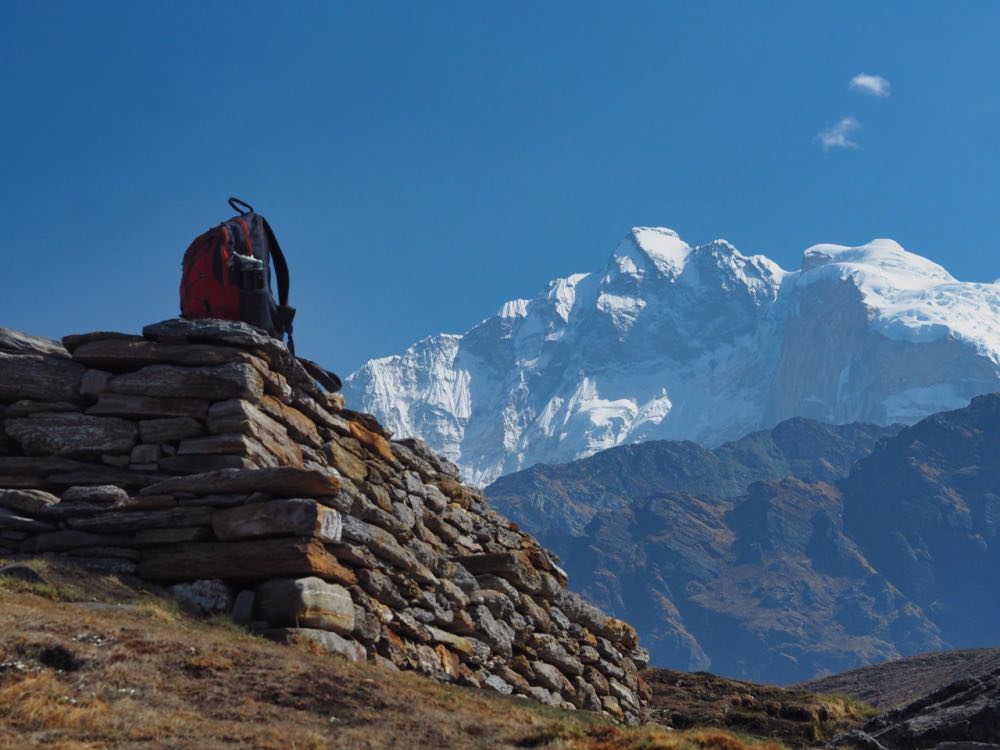
View of the Annapurna massif from Khopra Danda
EVEREST BASE CAMP
The 12-day Everest Base Camp Trek is a bucket list item for many serious adventurers. It’s not cheap. And it’s no stroll in the park, either. The base camp is at an altitude of 5,364 metres (17,600 feet), so the challenge becomes more severe the longer you’re into the trek. Again, it’s not something we’ve done so we can’t comment on our personal experience or suggest any tour companies. But there are plenty of them to choose from if you’re interested in doing it.
When is the BEST TIME TO VISIT NEPAL?
If you’re looking for perfect weather, the high season between October and mid-December would be your best choice. It’s warm and dry, the skies are clear and the trails are in great condition.
Of course, you’ll be sharing them with plenty of other people – and accommodation prices will be higher than at any other time – but if you’ve made it into the mountains you’ll want to take advantage of the perfect visibility.
The clear skies generally continue into January and February, but temperatures drop considerably at higher altitudes. Especially during the night. However, it’s a good time to explore the lower altitudes, such as the lakeside town of Pokhara or the safari parks of Chitwan and Bardia.
The spring months between March and May herald the arrival of huge blooms of rhododendrons, which blanket the hillsides and mountains in shades of violet, red, pink and white. March is also the month of the Holi Festival – perhaps more famous for its Indian version, but it also takes place across Nepal’s towns and cities, too.
As the season progresses, however, the ritual crop burning (and increasingly cloudy skies) can contribute to poor visibility in the Annapurna mountain range, creating poor hiking conditions there. Something we experienced during a visit in early-May when the mountains were engulfed in a constant haze until we reached an altitude of over 3200 metres. The conditions around Everest, however, are perfect at this time of year.
The monsoon season is between June and mid-September, bringing lots of rain and dangerous conditions for trekking. Visits to Kathmandu and the Kathmandu Valley are still possible, however, when the tourist crowds will have gone and accommodation prices are discounted.
Do I need TRAVEL INSURANCE FOR NEPAL?
The simple answer is yes – to visit Nepal, travel insurance (covering emergency medical treatment and medical repatriation) is mandatory. To be honest, given the potential hazards of trekking in the Himalayas, you really can’t afford to be without it anyway.
Seriously, don’t try and take shortcuts with your budget by ignoring insurance. Especially somewhere like Nepal, where airlifting you off the side of a mountain and repatriating you to your home country is going to cost you a not-so-small fortune. You might consider the likes of flight cancellations or lost baggage to be risks you’re happy to take. But medical cover, personal liability and emergency assistance should be a given.
Ultimately the type of insurance you need will depend on your own individual circumstances. We can recommend two insurance providers.
Being UK-based we use TrueTraveller, who offer a range of products to cover holidaymakers, adventure travellers and backpackers.
For non-UK based travellers, we can recommend SafetyWing, who provide global travel medical insurance for nomads all over the world.
How do I get a NEPAL VISA?
You can get a free single-entry visa on arrival for 30 days or a fee-based multi-entry visa valid for 15, 30 or 90 days.
Alternatively, you can book online up to 15 days before your arrival at the Department of Immigration’s website.
For the most comprehensive and up-to-date information, we use the online booking service through iVisa.
The current fees (September 2022) for multi-entry visas are: Up to 15 days – $30 Up to 30 days – $50 Up to 90 days – $125
What are the vaccination ENTRY REQUIREMENTS FOR NEPAL?
For the latest health-related entry requirements, please check this free online tool, courtesy of SafetyWing.
IS NEPAL SAFE?
Generally speaking, Nepal is a safe destination for holidaymakers and travellers, as long as sensible precautions are taken (such as not walking along unlit streets at night, accepting drinks from a stranger, or flashing expensive jewellery).
The Nepalese are very hospitable people and are welcoming to foreign visitors as tourism is vital to their economy. In fact, the biggest dangers you are likely to encounter are potential trekking accidents or contracting altitude sickness.
The political situation is relatively stable but there’s always the chance of an impromptu demonstration or two. You’d be best advised to stay away from them as they can get heated.
Is it essential to ACCLIMATISE before I visit?
No, you don’t need to acclimatise if you’re arriving in Kathmandu by air. However, at 1400 metres altitude, it’s a good place to spend two or three days to begin your acclimatisation if you’re planning on moving on to the mountains.
By comparison, the town of Pokhara, gateway to the famous Annapurna Circuit, is at an altitude of just 820 metres.
Problems with altitude sickness begin at elevations over 2500 metres. The name of the game is to take it easy – especially in the early stages. The best general advice is to eat lots, drink plenty and take the occasional rest day.
Here’s the UK’s NHS advice on the subject.
NEPALESE FOOD
Nepalese food varies considerably depending on ethnicity, geography and, not surprisingly, altitude. Also influenced by neighbouring India and China, it’s generally light on spices and high in carbohydrates. These are some of our favourites:
GURUNG BREAD WITH LENTILS
Probably the most satisfying meal we’ve had in Nepal, yet also the simplest. Home-made, shallow-fried millet and corn bread, served straight from the pan with a side helping of lentil curry. A heartwarming way to start the day in preparation for a full day of trekking. We enjoyed this one for breakfast at the tiny hamlet of Ghandruk, en route to Khopra Danda.

Gurung bread with lentils, Ghandruk
MOMOS WITH CHILLI SAUCE
Steamed dumplings made with flour dough and served with a chilli dipping sauce. Simple, no-nonsense comfort food that has sustained many a backpacker in Kathmandu and beyond.
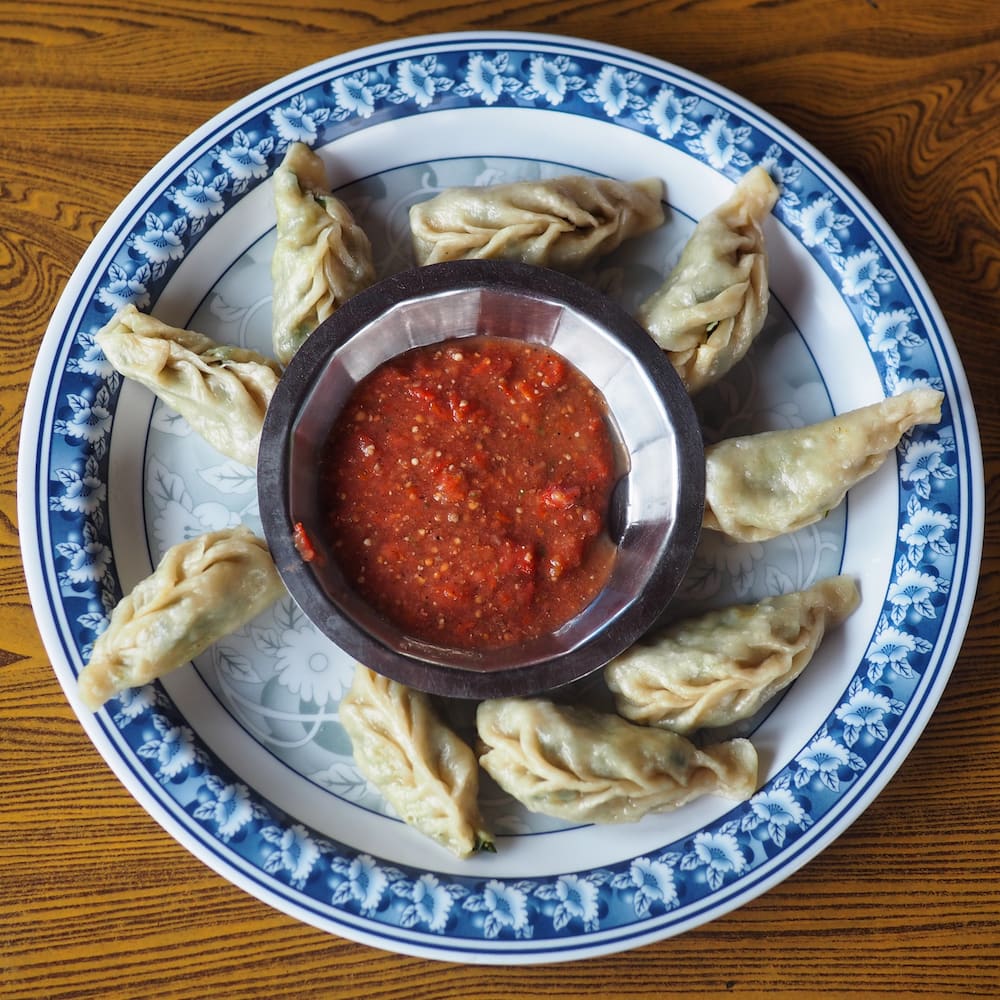
Momos with chillis sauce, Kathmandu
DAL BHAT TARKARI
One of Nepal’s iconic dishes. It combines dal (a soup of lentils and spices) and bhat (rice) with tarkari (a vegetable curry) and spiced pickles, such as dried mustard greens and radish. For the weary trekker, the good news is that it normally comes with free additional helpings. Although we must confess, it was all a little bland for our tastes. We’ll probably carry our own bottle of chilli sauce next time!
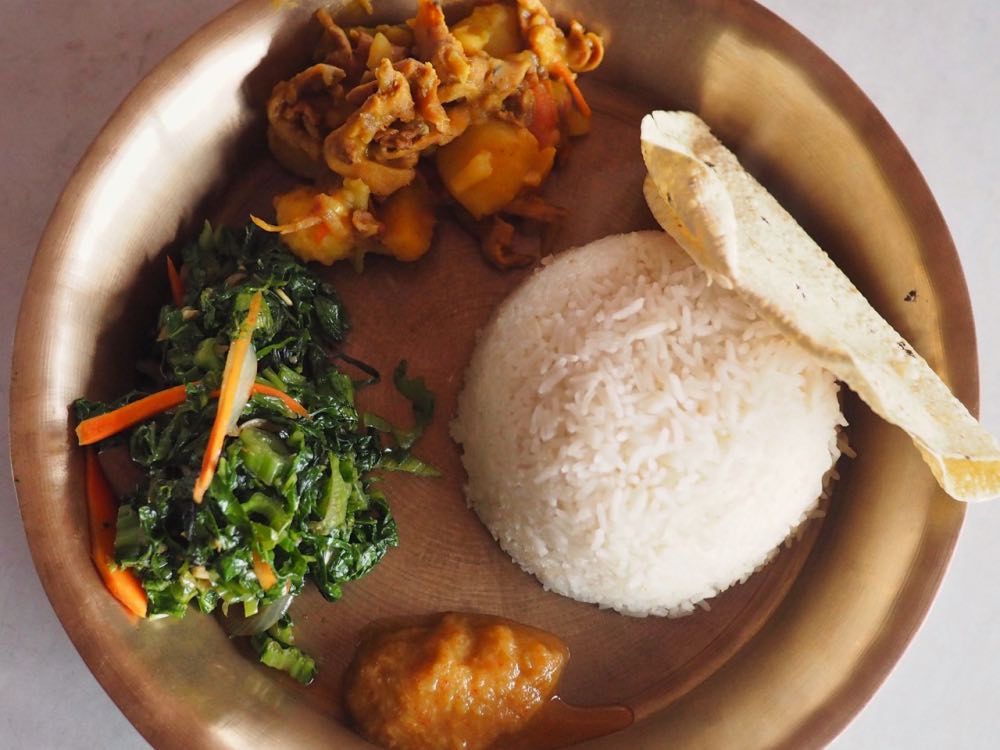
Dal Bhat Tarkari, Khopra Danda
DUCK AND AUBERGINE IN CHILLI SAUCE
From the bland to the searingly hot. We ate this dish at a Tibetan restaurant in Boudhanath. More like a Chinese Szechuan dish than Nepalese if we’re honest. But it’s an example of some of the variations to be found from the usual Nepalese fayre. Although a little heavy on the oil, the richness of the duck combined superbly with the smoky, charred aubergine and lip-smarting chilli. Antacid tablets on standby are recommended.

Duck and aubergine in chilli sauce, Boudhanath
For a larger selection of Nepalese foods to try, check out these articles:
20 Most Popular Nepali Foods by Chef’s Pencil
Nepalese Food: 25 Stunning Dishes You Must Try by Stunning Nepal
The 2015 EARTHQUAKE
Visit Nepal and you can’t fail to appreciate the enormity of the catastrophic earthquake that struck 40 km from Kathmandu on 25 April 2015.
It left 9,000 dead and 22,000 injured, laying waste to more than 600,000 structures in and around the Kathmandu Valley.
And if that 7.8 magnitude earthquake wasn’t enough, subsequent aftershocks increased the death toll and destruction even further. Rural villages were destroyed by landslides. It set off an avalanche on Mount Everest, stranding hundreds of climbers and killing 19 more. And thousands of families were forced to endure monsoons and freezing winters in makeshift shelters for years to come.
Needless to say, for a country already considered to be one of the poorest in the world and yet so reliant on tourism, this was a disaster beyond equal.
We visited Nepal 12 months later and the destruction was still very palpable. In centuries-old city squares, there were now mounds of rubble where grand temples and palaces once stood. Those that remained were being supported by huge wooden poles. Old bricks that were laid hundreds of years ago were now piled up on street sides. And, all around, the air was thick with dust as local people relentlessly swept their doorsteps.
Since then, over 800,000 earthquake-resilient homes have been built, along with over 8,500 schools, health facilities and government buildings. The recovery programme is all-but completed. But, with the double-whammy of the COVID-19 pandemic wiping out any tourism rebound until 2022, the returning trickle of tourists can’t come soon enough.
If any country, and specifically its people, deserves some luck and the influx of tourist dollars, it’s Nepal.
And that, if nothing else, is a reason to visit Nepal all on its own.
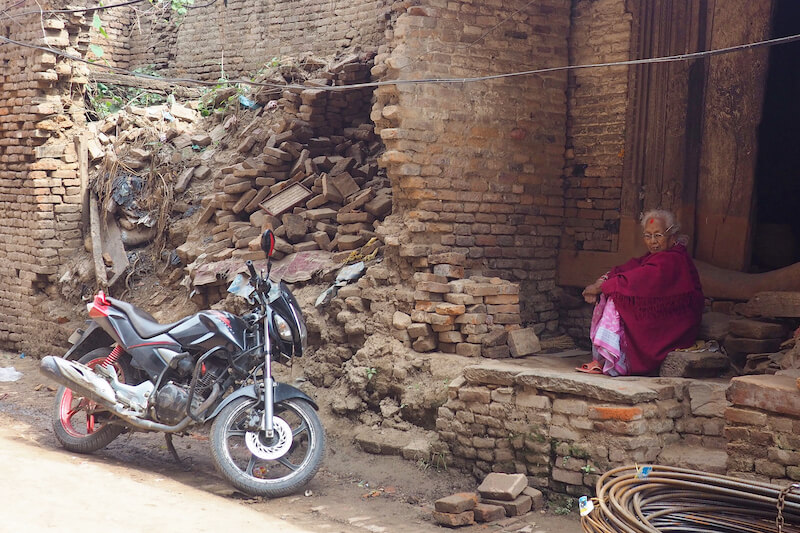
Earthquake damage in Bhaktapur during our 2016 visit
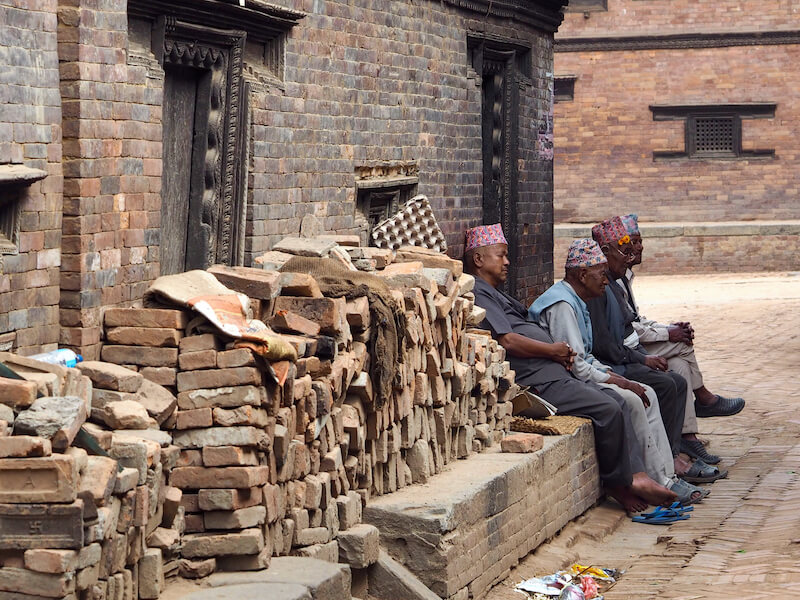
More rubble in Bhaktapur
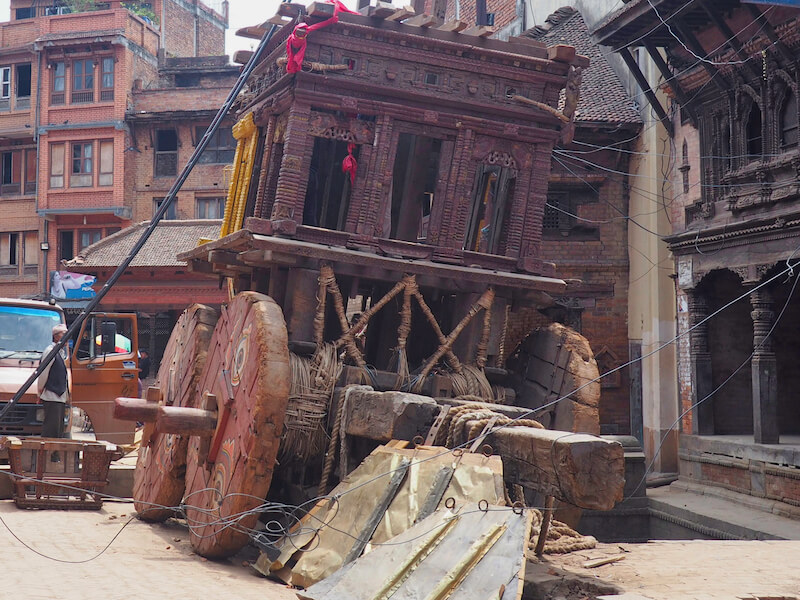
Attempts to repair a tower come unstuck
LINKS
NEPAL OFFICIAL TOURIST SITE
NEPAL TRAVEL BLOGS
For a more detailed look at Nepal, we’ll happily defer to bloggers who’ve spent a lot more time in the country than us.
One of our favourites is Charlotte Plans A Trip.
Another is The Common Wanderer. In fact, we doubt there’s a more comprehensive blogger’s guide to Nepal than Mark & Mim’s.
And then there’s A Little Adrift – Shannon O’Donnell’s blog was one of the first we followed when we started travelling back in 2015. And it’s still one of our go-to sites today.
NEPAL TRAVEL GUIDES
Here are links to the relevant pages of some of the well-known travel guide titles.
KHOPRA DANDA
EVEREST BASE CAMP
KATHMANDU
BHAKTAPUR
PATAN
LUMBINI
BANDIPUR
POKHARA
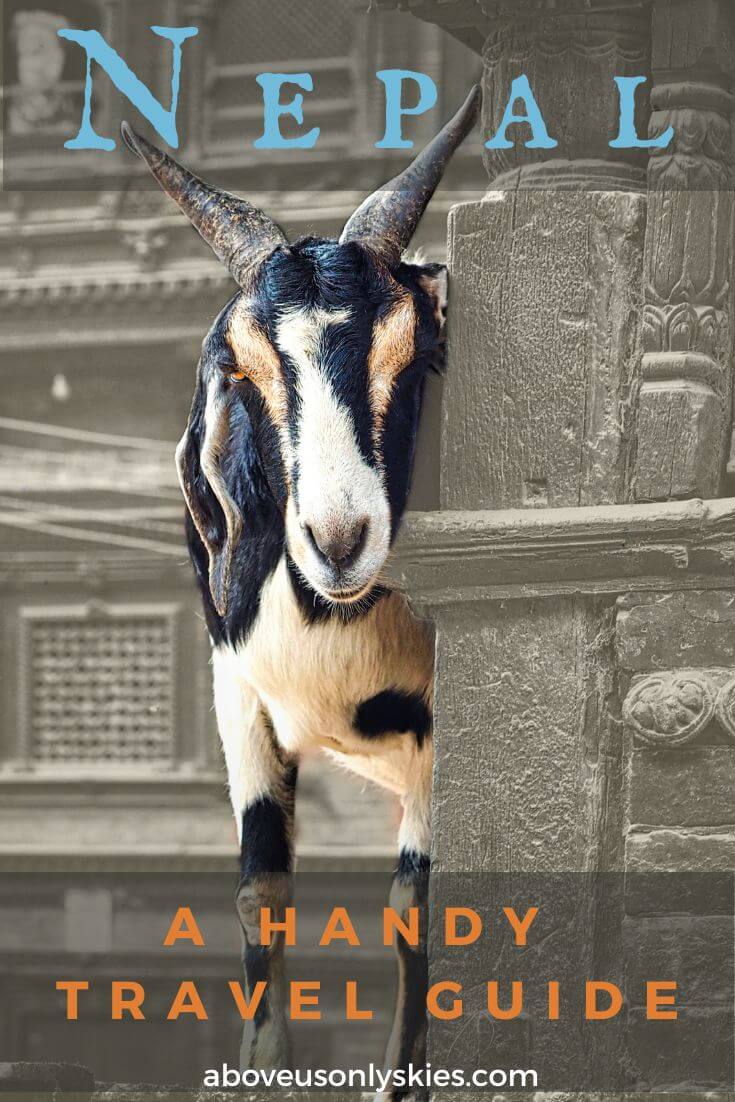
THANKS FOR READING
Hi, we're Ian and Nicky, an English couple on a voyage of discovery around the world, and this blog is designed to reflect what we see, think and do. Actually, we'd like to think it also provides information, entertainment and inspiration for other “mature” travellers, too. So please feel free to pour yourself a glass of something suitably chilled and take a look around.

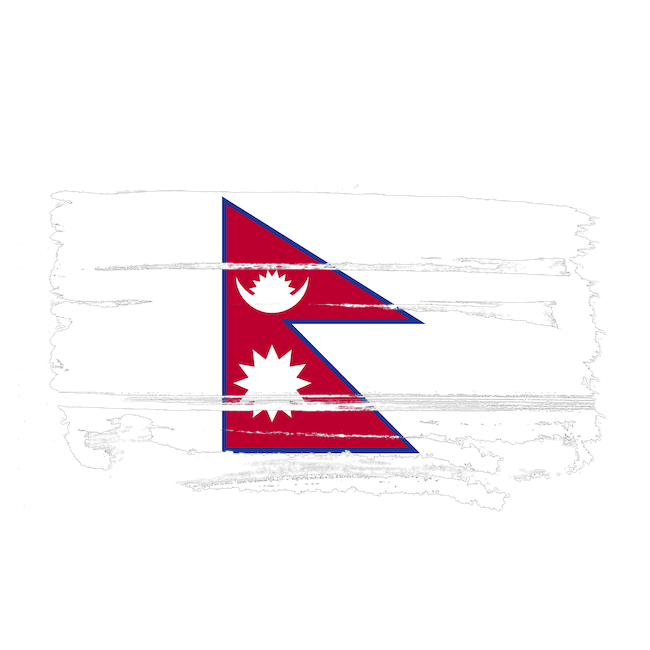
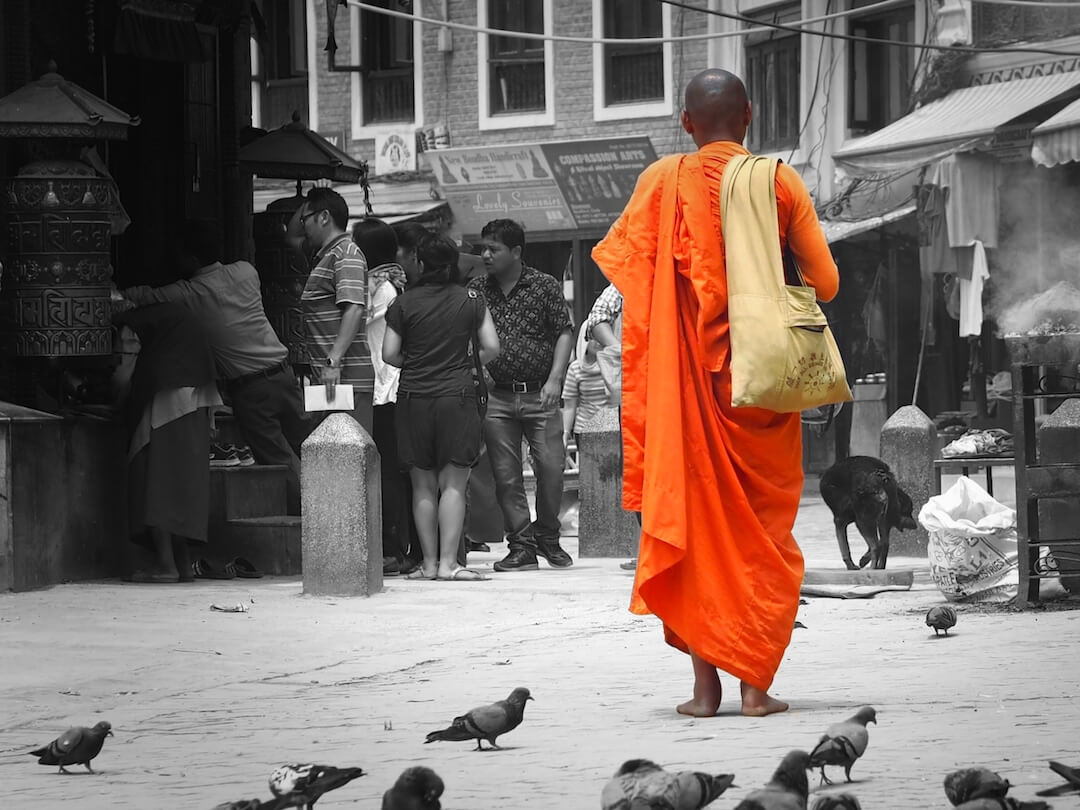
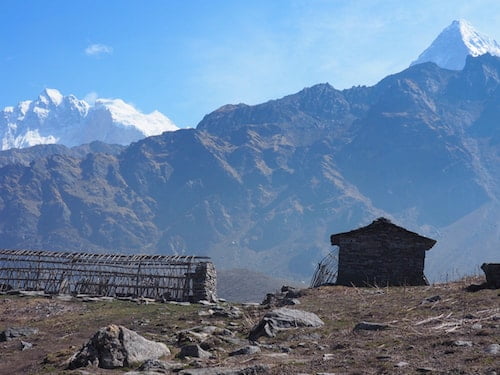

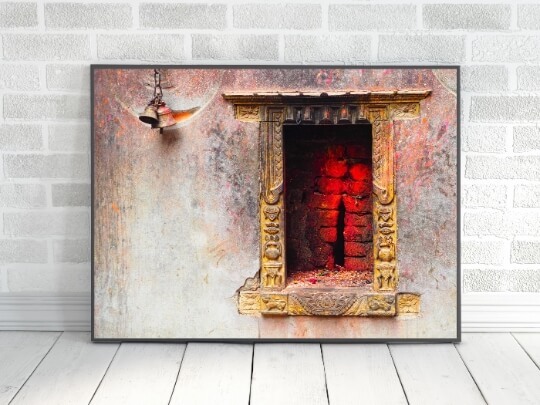

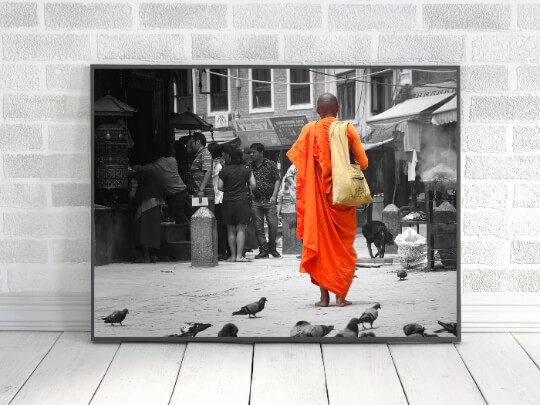

So many informative articles that help people visit Nepal